Menu
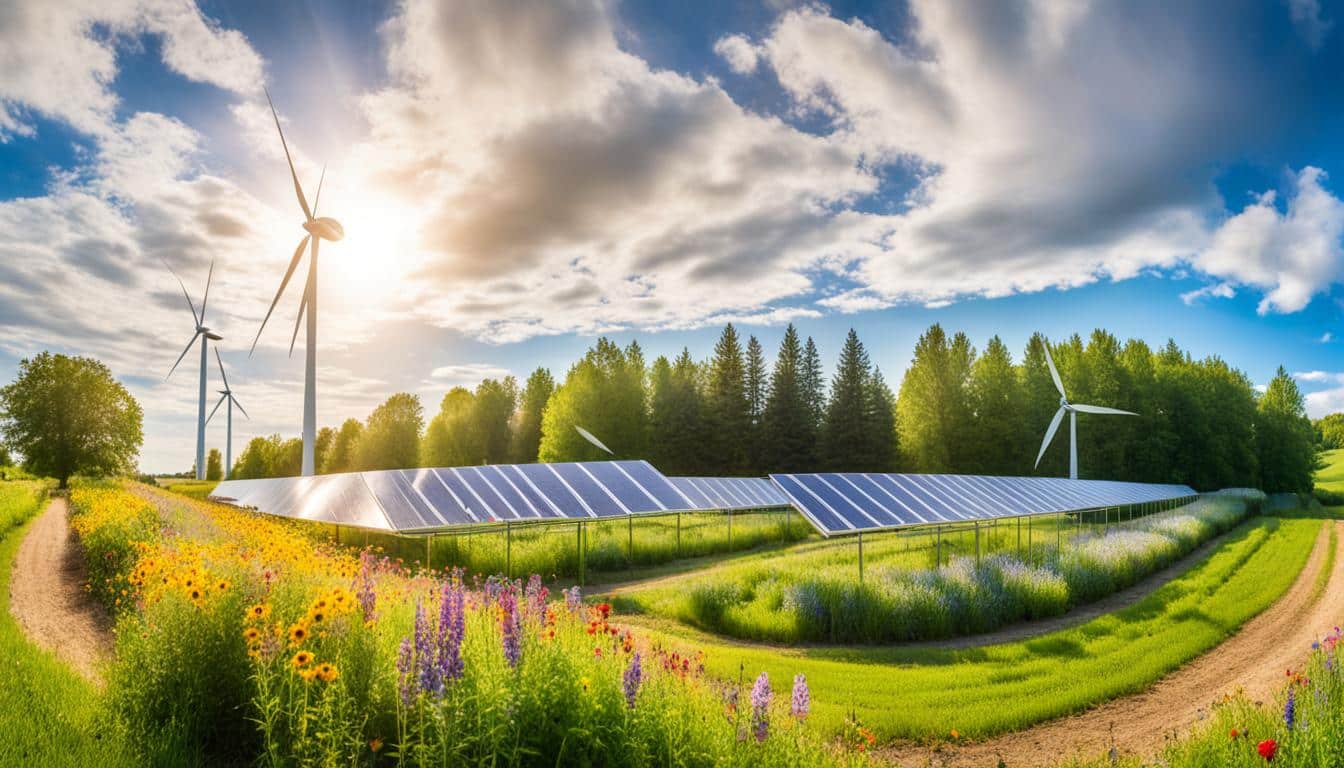
Did you know farms that practice intercropping can make soil 20% healthier? They also cut pest numbers by 15%. This comes from years of studying how to farm in ways that are good for the environment. Now, farmers are using methods like planting cover crops and perennials to taking care not to dig too much. These methods help agriculture be good for nature.
When farmers grow many different crops and keep changing where they plant, the soil stays healthy and stops washing away. Using methods that don’t hurt the soil means it stays in place 40% more. Also, by dealing with pests in smarter ways, we use 50% less chemical spray. This shows we can farm well and protect the Earth at the same time.
Mixing crops with raising animals helps farms work better. This way, they can produce more food and lower their costs. When farmers also grow trees, they earn extra money and keep the soil healthy.
Taking care of the soil is at the heart of this way of farming. Healthy soil grows better crops, which means more food and money for farmers. Also, by farming more like nature does, we can keep going for a long time.
Realising the harm of traditional farming on the Earth pushed the need for eco-friendly farming. It focuses on using methods that are good for the planet. These methods aim to last long and keep nature in balance. They understand how farming impacts things like the soil, water, and local pollution. By choosing green agricultural techniques and bio-dynamic farming approaches, farms can do better for the environment and still be productive.
Sustainable farming involves practices that lower the harm of farming on the Earth. It does things like composting, growing many crops together, and planting old varieties. It tries to balance getting a lot of food with protecting the environment. This is unlike big, industrial farms that often harm the environment to produce more.
Those practices aim for less pollution, saving natural areas, economic health, and safe working conditions. They include taking good care of the soil. This is done by using fertilisers wisely, changing what crops are planted each year, and by planting crops that keep the soil healthy. Practices like bio-dynamic farming also fit in, as they see the farm as a whole living system.
Thinking carefully about how water is used in farming is also very important. Methods like drip irrigation and good water management can save a lot of water. Using these methods can reduce water waste by half. This shows that using less water is a key part of eco-friendly farming.
| Practice | Environmental Impact | Economic Benefit |
|---|---|---|
| Crop Rotation | Increases crop yield by 10-20% while preserving soil fertility | Reduces the need for chemical fertilizers |
| Drip Irrigation | Reduces water wastage by up to 50% | Efficient water resource management |
| Subsidies on Green Technologies | 30% increase in farmers adopting eco-friendly practices | Enhanced productivity through technology |
Working together is how we can make eco-friendly farming happen more. Public and private groups working together have already made big steps. They have grown the use of sustainable farming by 40% through sharing resources and knowledge. This teamwork, along with following green agricultural techniques and bio-dynamic farming approaches, can keep agriculture both productive and good for the planet.
Sustainable farming is key for making enough food without harming the planet. With our population on track to hit 10 billion by 2050, the pressure is on. Such a big number means we need to boost food production by 70%. This demand highlights the crucial role of ethical farming practices that save resources and protect the Earth.
Farming affects the lives of over one billion people who depend on it for a living. Sustainable methods cut down on water, use natural fertilisers, and improve soil. These steps help make sure the land stays rich and ready for growing. This builds a strong base for farming that can withstand challenges.
But, sustainable farming isn’t just about the environment. It also brings better money and life to farmers. It means using fewer natural resources and making the soil and water better by rotating crops. Small farmers can produce more this way, making their businesses stronger. This leads to fairer food markets and healthier local communities.
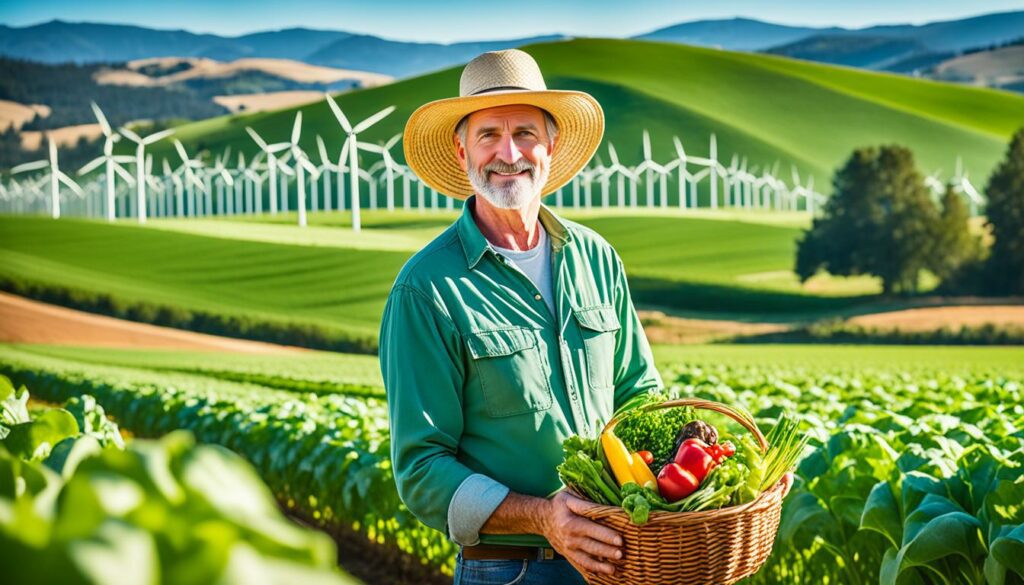
Using sustainable ways makes our food system more reliable and better for nature. Even things like choosing to eat vegan or supporting local farms can help. Together, these choices can lead to a food future that is both ethical and sustainable. In the end, sustainable farming is critical for saving our environment, keeping the economy strong, and ensuring everyone gets food they can afford, all while protecting the planet.
Sustainable farming benefits from using different crops and methods like crop rotation and intercropping. These help soil, fight pests better, and increase how much we grow.
Changing the type of crop each season boosts soil life and farming success. It helps fight pests and keeps the soil full of the right nutrients. This means we don’t need as many chemicals to grow our food.
From studies, using different crops together can make farming 37% more profitable. And it makes the soil much better for future crops. This is good because it means we can grow food without hurting the earth.
Planting two or more crops close together is called intercropping. It makes farms more diverse and the food we grow better. For example, planting beans with grains can add more nitrogen to the soil naturally. This way, we use less artificial stuff to grow food.
Adding animals to farming can also help it become more productive and make more money. This is important for having strong and healthy farms.
Places like the North China Plain show that using different crops can really boost farming. By mixing things like sweet potatoes and wheat, they made 38% more food and up to 60% more money. This is compared to growing just one type of crop.
This kind of farming also makes the soil much healthier. It can even help lower the gases that harm our planet by 39%. This way of farming protects our world and helps our economy grow.
It’s important to farm in ways that last. Using different crops and methods helps our farms do well and not harm the earth. The good things these methods bring are key in today’s farming.
Using cover crops and perennials makes farming more sustainable. It boosts soil health and brings many financial and environment pluses. Cover crops help fight soil erosion, up nutrient levels, and cut the need for fertilizers and herbicides. Perennials keep the soil covered year-round, helping create a healthy soil ecosystem.
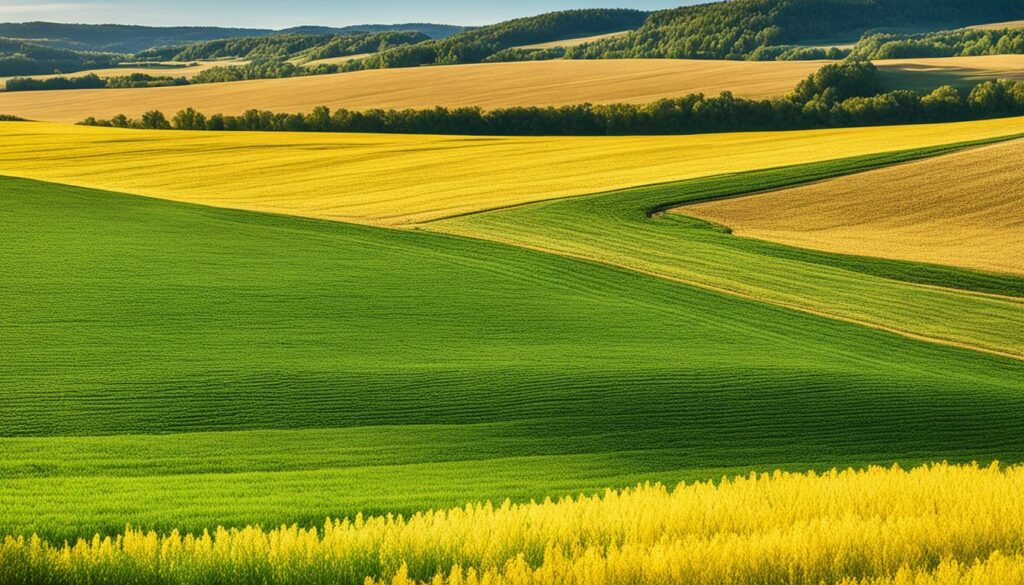
Cover crops are key in handling changing climates, like more heavy rains. These rains can wash away nutrients and erode soil. But, cover crops reduce this issue by making soil better at keeping moisture and nutrients in. They also stop soil from getting too hard, lower nutrient loss, and reduce pests, which is great for soil health. Plus, they help crops grow more, cut down on machines needed, and deal with weeds.
Perennials protect the soil all the time. They help keep the ground stable, control nutrients, and lessen the need for fertilizers and herbicides. With soil always covered, its quality keeps getting better. Starting these crops early and using their toughness in cold and wet also help a lot.
Many farmers and experts see better crops and spend less by using cover crops and perennials. In 2017, 15.4 million acres had cover crops, 50% more than five years before. This shows how much these methods are liked and make a difference in farming over time.
| Crop Type | Benefits | Challenges |
|---|---|---|
| Cover Crops |
|
|
| Perennial Crops |
|
|
No-till farming and reduced tillage are key in farming today, especially for keeping soil healthy. Methods like no-till, strip till, and mulch till can lower the number of times we dig the soil by 40% or more. This helps keep the soil in good shape.
In California, nearly half of the land for growing yearly crops was using these methods by 2010. The goal is to increase this to more than half by 2028. Doing so keeps crop remains on the ground, stopping wind and water from carrying away the soil and its nutrients.
The pluses of no-till farming are clear: it reduces soil loss and cuts both fuel and production costs. Events like the UC ANR Conservation Agriculture Systems Innovation conferences help spread the word. This leads more farmers to try these methods.
But, we need to be careful in how we do no-till farming. Badly done no-till can create new problems, like too many pests around. Expert farmers, including Phil Foster and Scott Park, show us the right way. They prove that no-till and reduced tillage work well.
Research by Luna, Minoshima, and Mitchell has shown that gentle tilling helps the soil and the environment. It keeps more carbon in the soil, holds water better, and makes the soil stronger. Plus, it lowers the gases that harm our planet.
Integrated Pest Management (IPM) is key in eco-friendly farming. It started in 1979 at UC Agriculture and Natural Resources. Back then, it focused on nine top crops in California. Now, it helps with pest control for over 65 different crops.
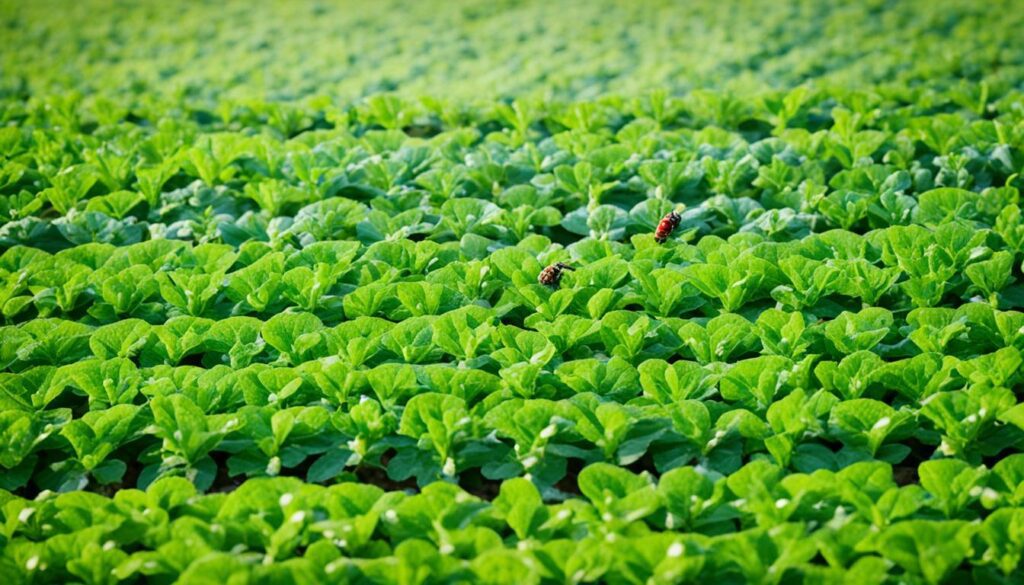
UC Agriculture and Natural Resources offer many resources for farmers. This includes both free and paid materials. They also provide tools like degree-day calculators and risk assessments. These help with pest control.
IPM uses methods to control pests without chemicals. UC opened the Center for Biological Control in 1954. It showed UC’s commitment to finding biological solutions. These methods are good for the environment.
IPM promotes using fewer chemical pesticides. It uses steps for identifying and managing pests without chemicals. This cuts down on harmful chemicals in the environment. It makes farming more sustainable.
IPM’s impact is felt worldwide. It supports food safety and reducing pesticide use. Studies show it’s part of a growing trend towards eco-friendly farming. UC’s IPM works with others to keep pest management effective and up-to-date.
Integrating livestock with crops boosts both farm productivity and the environment. Every year in the U.S., the manure from millions of cattle, hogs, and chickens saves 23 million tonnes of nitrogen. This shows just how effective combining animals and crops can be.
Research from the USDA shows great benefits in joining animals with crops. For example, a 100-cow dairy farm’s manure is worth over $20,000 a year. Manure from a 100-sow farm is valued at $16,000 yearly. This proves the strong economic value of this mix. Also, a 20,000 bird broiler operation adds about $6,000 of income from its manure.
Today, many farmers are turning to composting manure. It’s because composting stabilises nutrients and reduces the amount to spread. They find that turning manure into compost can help it fit the needs of different crops.
Universities like Iowa State and the University of Minnesota confirm that crops and livestock together make soil healthier. They also lower carbon levels and help control pests. Tests showed that mixed farming was not only more profitable but also healthier and safer for food production.
Customers prefer meat from certain farming methods. For instance, beef from steers that graze winter wheat is more liked than that from steers eating winter rye. Steers with mixed breeds, like Jersey, Normande, and Viking Red, are chosen over Holsteins for better taste and omega-6/3 balance.
Integrating crops and livestock is good for many reasons. It helps with recycling nutrients and building strong, natural farming systems. This kind of farming can stand up to climate change and benefit the farm in many ways.
| Operation Type | Estimated Manure Value ($) |
|---|---|
| 100-cow dairy farm | 20,000 |
| 100-sow farrow-to-finish | 16,000 |
| 20,000 bird broiler operation | 6,000 |
Agroforestry combines trees and shrubs with crops and animals on the same land. This mix brings many benefits, like better soil and less erosion. It also helps restore forest areas. The right trees for agroforestry are strong, do many jobs, don’t take over, and are easy to care for. They offer extra products besides wood.
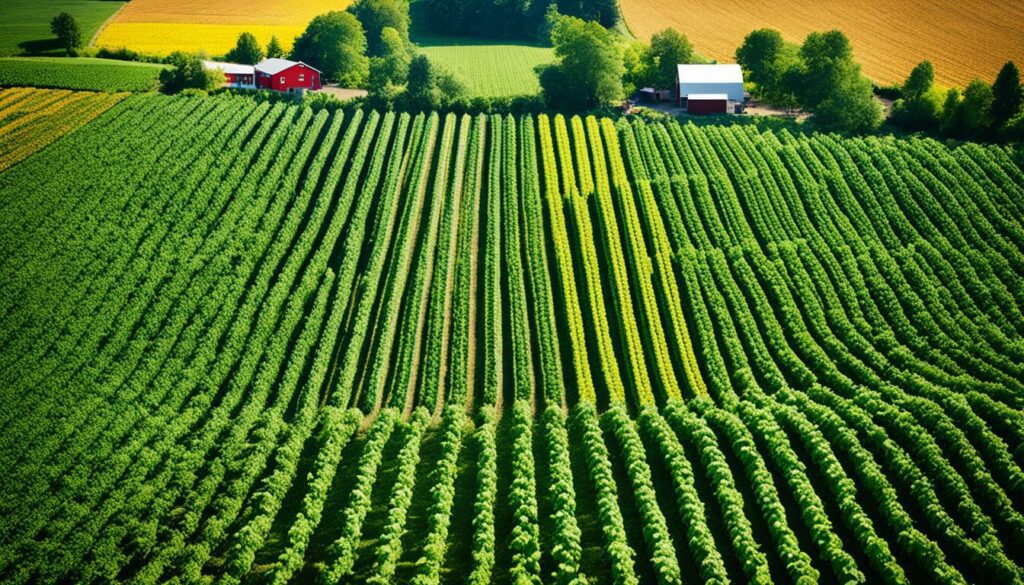
Adding trees to farms can help land recover, improve crop quality and amount, and make farming last for the long term. It makes the soil healthier and keeps nature balanced. Trees also protect against strong winds and offer shade, making farms stronger.
Growing trees and shrubs together with crops makes a rich home for many living things. Methods like planting trees in lanes between fields and mixing trees with grazing animals are common. These methods help soil and bring in more money from selling fruits, nuts, and herbs.
Agroforestry helps many animals and plants find a good place to live. Trees and shrubs bring in helpful insects that protect crops by eating harmful bugs. They also help the soil stay healthy without needing chemicals, and they add important nutrients.
| Benefit | Explanation |
|---|---|
| Landscape Restoration | Helps in rehabilitating degraded land and restoring ecological balance. |
| Increased Crop Yields | Enhances productivity and quality of crops through improved soil health and pest control. |
| Economic Development | Provides farmers with diverse revenue sources, reducing financial risks. |
| Food Security | Contributes to stable food production and availability. |
| Energy Savings | Windbreaks and shade from trees reduce building energy requirements by over 20%. |
Changing and adapting how we do agroforestry is key to success. It depends on the local area. Visiting sites often and working closely with local leaders and farmers is very important.
Efforts from the past, like those started by Franklin D. Roosevelt, show us the great things trees and shrubs can do for the land and water. Trying new ideas, like planting certain crops before trees, can make the soil even better. This sets a strong start for agroforestry.
Agroforestry is more than just planting trees on farmland. It builds a richer environment for plants and animals. It also helps farmers earn more. This way of farming keeps earth healthy and supports a good life in the countryside.
Using a whole systems approach is key to sustainable farming. This method helps protect the ecosystem. It also improves soil quality and increases the variety of life on the farm.
Natural plants are vital for farms. They help by attracting good insects and making the land healthier. This means farmers need to use fewer chemicals.
Adding strips of prairie plants protects against erosion. These strips slow down water and keep soil in place. They also help keep water systems healthy, which is good for the whole farm.
| Farming Element | Contribution | Impact |
|---|---|---|
| Natural Vegetation | Supports pollinators & beneficial insects | Increased biodiversity, improved pollination |
| Prairie Plant Strips | Reduces soil erosion & water runoff | Enhanced soil stability, effective erosion control |
Sustainable agriculture aims to create living soil. This is a rich ecosystem full of helpful microorganisms. These little helpers keep nutrients cycling, boosting plant health. Practices like no-till farming help keep the soil healthy by reducing erosion. They save topsoil and prevent nutrient runoff. This runoff can pollute local water systems.
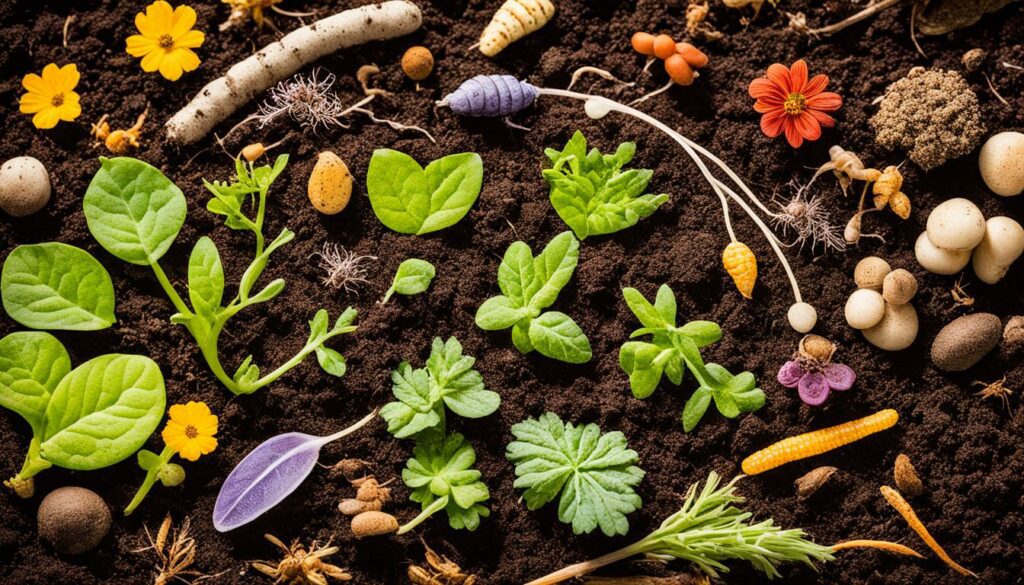
Cover cropping and adding organic matter to the soil increase fertility. Enriching the soil this way allows it to hold onto important nutrients. This enables crops to grow strong without harming the land. Keeping the soil in good condition is crucial for both the environment and farm productivity.
Creating a diverse soil ecosystem helps support pollinators. It provides a home for beneficial insects. These insects, like bees, are vital for many crops. Their well-being depends on the health of the soil where they work.
Practices such as crop rotation and use of organic fertilisers are clear winners. They improve soil health and protect essential nutrients. These methods work together to create a strong agriculture system. It helps pollinators thrive and stops harmful nutrient runoff.
| Practice | Benefit | Result |
|---|---|---|
| Cover Cropping | Erosion Control | Preservation of Topsoil |
| No-Till Farming | Reduced Soil Disturbance | Enhanced Soil Structure |
| Organic Fertilisers | Balanced Nutrient Supply | Improved Crop Growth |
| Crop Rotation | Pest and Disease Management | Lowered Chemical Dependency |
Sustainable agriculture builds strong, life-filled soils. These living soils aid healthy crops. They lower nutrient runoff and benefit pollinators. This creates a farming system that’s both productive and balanced with nature.
Sustainable farming is good for the planet and wallets. It helps farms make more money and spend less. This happens when farmers care for the earth as they grow their crops.
Compared to regular ways of farming, sustainable methods can boost profits by up to 25%. This is because smart tech and earth-friendly ways cut costs. For example, less fertiliser and pesticides mean saving money. This leads to making more crops without spending a lot.
Sustainable farming not only makes more money. It also saves costs for the future. Methods like using less water can lower bills by half. Taking care of the soil and using less inputs also means farms can keep being successful in the long term.
In the end, sustainable farming is great for both money and the earth. It’s a path that leads to more profits and less waste. This way, farms can stay strong and keep providing food for all of us.
Climate-friendly farming is key to sustainable agriculture. It aims to cut down on the harmful effects of traditional farming. One main aspect is to lessen or stop tilling the soil. This can reduce greenhouse gases as much as taking 12.4 million cars off the road. It shows how much good it can do for the planet.
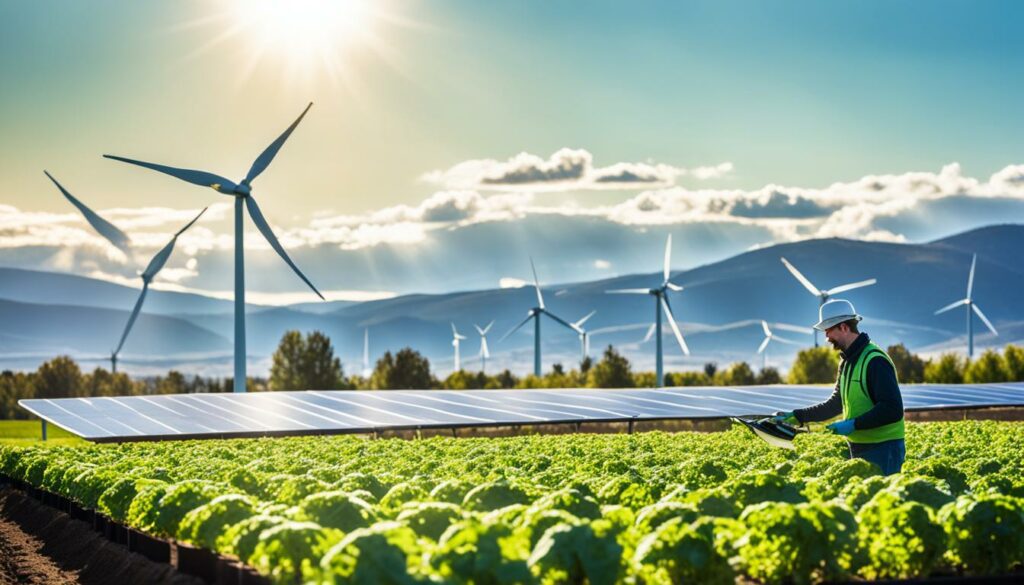
Using water wisely is also crucial in green farming. Changing from high to low pressure in pivot irrigation can save a lot of water. It cuts evaporation by 15%. This is important in areas with not much water. Drip irrigation systems use much less water than before. They help crops grow while saving water.
Cover crops play a big role too. They keep the soil healthy and stop it from washing away. When these crops are used for grazing, it saves money not spent on feed. Adding organic matter to the soil through these crops is good for the planet. It can boost soil health by storing more carbon, which is needed in eco-friendly farming.
“Green agriculture practices have been shown to increase soil organic carbon sequestration by up to 28% compared to conventional farming methods.”
New technologies like precision farming are making a big difference. They can up crop yields by 25%. But they use 30% less water and cut down on fertilisers by 70%. These stats highlight the need for tech in making farming more earth-friendly.
| Technique | Benefit |
|---|---|
| Low-pressure drop tubes | 15% water saved |
| Cover crops | Soil protection, grazing potential |
| Drip irrigation | 30-60% water reduction |
| Precision farming technologies | 25% higher yields, 30% less water, 70% less fertilizer |
These farming methods help create a stronger, more diverse ecosystem. They make farms able to withstand pests and bad weather better. This strength is crucial in fighting climate change.
It’s also vital to think about pollinators, such as bees and butterflies. They need us to protect their homes. Doing this in eco-friendly farms boosts pollination and biodiversity. Projects like Illinois’s Clean Sweep help keep insect habitats safe too.
To sum up, adopting green farming practices isn’t just about the environment. It makes farms stronger and more profitable. Farmers using these methods are better prepared for the future. They’re also doing their part to help the Earth.
Organic farming is all about using natural ways to grow food. It’s based on keeping a balance in nature and using things in a way that will last a long time. This helps keep our planet healthy and farms able to grow food for the future.
Organic farming focuses on nature’s own methods, avoiding chemicals. It uses things like changing which crops are planted, having special cover crops, and natural ways to keep pests away. These methods help keep the soil full of life and healthy. They also help the soil trap more carbon, which makes the soil better at growing food.
Moving to organic farming means changing a lot in how we grow food. The goal is to use less man-made chemicals on the land. For example, planting certain crops between main crops can stop the soil from washing away and make it richer. Using special water systems can also help save water and energy, making farms kinder to the environment.
“Organic farming accounted for 3 percent of total sales within the United States’ food industry in 2012, with a growing trend towards more land being allocated for organic methods.”
In Europe, countries like Finland, Austria, and Germany want to use 20% of their land for organic farming. Bhutan plans to be fully organic by 2020, and Sikkim in India already hits 100% back in 2016. These are big steps toward healthier farming for the planet.
| Country | Organic Farming Goals |
|---|---|
| Finland | 20 percent land area for organic farming |
| Austria | 20 percent land area for organic farming |
| Germany | 20 percent land area for organic farming |
| Bhutan | 100 percent organic by 2020 |
| Sikkim, India | Achieved 100 percent organic status in 2016 |
Eco-friendly agriculture is always growing with new ideas to improve farming. It focuses on making farms more productive while not harming the environment. 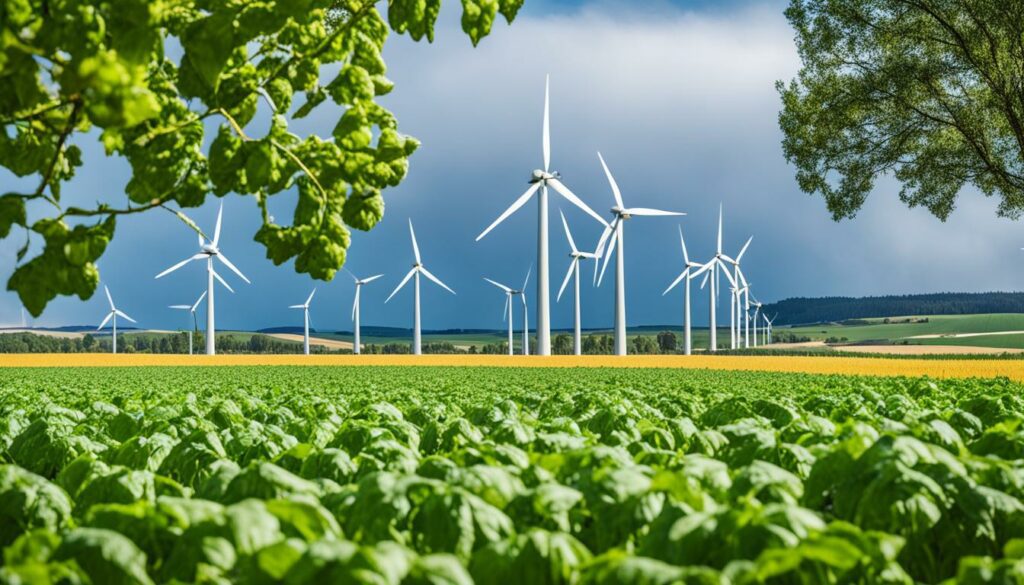
Precision farming has changed how we farm, using resources more wisely. The USDA says it can use less water, fertiliser, and pesticides. This way of farming helps the planet by reducing waste and pollution.
Vertical farming is a big step forward in agriculture, growing more food in less space. It uses much less water and doesn’t need pesticides. This is a great move towards more eco-friendly farming methods.
Regenerative agriculture is also making a difference by improving the soil and taking in carbon. It can make the land healthier, connecting farming with nature better.
Livestock production is also changing to be cleaner for the earth. Things like letting animals graze on different parts of the land can make the soil better and reduce bad emissions.
Blockchain technology is starting to be used in farming to show where our food comes from. It helps people know their food is safe and came from a good place. Food Safety Magazine explains how it works.
AgriMAX is a leader using these new farming methods. Their work with different crops and covering the soil to keep it healthy shows how farming can be better for the planet. They use less chemicals, too.
Integrated Pest Management (IPM) is another method they use to keep the land and crops healthy. It means they try not to use harmful chemicals. AgriMAX is really working to farm in a way that doesn’t hurt the earth.
AgriMAX is also using solar panels to power their operations. This cuts down on pollution and saves money. It’s a great way to show that farming can be good for the environment.
These new farming methods are exciting for the future. They show that it’s possible to farm in a way that’s good for making food and for the earth. It’s all about finding ways to work with nature, not against it.
The road to sustainable farming has many hurdles. These include complex weather patterns and economic issues. But, by using solid plans, these challenges can be met. We will look at the main hurdles in sustainable farming and how to solve them.
Climate change is a huge obstacle to sustainable farming. Rising temperatures and erratic weather harm crops. Also, over-farming and bad irrigation lead to poor land and water. To tackle this, we must work on several fronts:
Going green in farming needs good plans. Effective ways to achieve this include:
In summary, facing and beating the hurdles in sustainable farming takes smart and informed steps. Choosing these paths helps us move to a future where farming is both green and fair.
The future of agriculture looks towards sustainable farming. This approach has grown in popularity over the last forty years. Sustainable agriculture aims to keep the environment healthy, make profits, and be fair to everyone.
It uses natural and human resources wisely. This helps create a farming future that is strong and able to change. This method considers how farming affects the environment and people. It adapts to new challenges and different opinions.
Sustainable farming can boost the amount of food we produce. It also cuts down on harmful emissions by taking care of the soil. Protecting various plants and animals helps keep the whole system in balance. To make this happen, rules and support from the government are critical. Plus, the public needs to know about the benefits of these farming methods.
In the end, the road to sustainable farming is always moving forward. It needs constant effort, new ideas, and accepting change. The benefits go beyond just the earth, including strong economies and the health of people. Working together to use our planet’s resources well will define the future of farming.
Eco-friendly agriculture is all about farming in ways that are kind to the planet, keep the soil healthy, and look after the people who work the land. It focuses on using methods like growing different types of crops together, not ploughing too much, and planting crops to cover the ground.
Growing different crops together makes the soil better, helps control pests, and uses less man-made stuff. This includes planting different crops in the same field each year or at the same time, which makes farms more productive and able to handle bad times better.
Cover crops and plants that live for many years help keep the soil in good condition and fight off weeds without needing lots of chemicals. Perennials also keep the soil healthy and full of good nutrients all year round.
Not ploughing the land or doing it less helps stop the soil from washing away, keeps it healthy, and adds more carbon to it. This method keeps water in the ground, makes the soil’s structure better, and cuts down on gases that harm the environment.
IPM means tackling pests in a smart way by using things like traps or natural predators instead of lots of chemicals. This approach helps reduce the harm to the environment caused by pesticides.
Having both animals and crops on a farm helps nutrients and life cycles flow better, making farming more sustainable and profitable. It improves the overall performance of the farm.
Agroforestry mixes crops with trees and bushes, adding money-making opportunities and helping nature. It’s good for the environment, providing places for various wildlife and extra food sources.
This farming method includes wild areas in the farm to stop soil loss and keep the land more fertile naturally. It helps keep pollinators and other beneficial creatures around, supporting a healthy farm.
Sustainable farming creates a vibrant soil full of life that’s needed for plants to grow well. It stops the soil from being damaged or lost, which is key for lasting farming success.
Farming this way boosts how much you produce, cuts back on costs, and ensures your farm can thrive for a long time. It’s good for making more money in the future while taking care of the land.
By doing things like rotating crops or using natural ways to grow food, farming can actually help the climate. These practices take less from the planet and lower the impact on the climate.
Organic farming is all about fitting in with nature’s ways and using what it naturally offers. It looks after the earth, keeps it alive and healthy, and balances farming with the world around us.
Starting to farm organically can be tough because of the money and knowing how. But, learning what to do, getting help from policies, and sharing tips can make it easier for farmers to switch and stay with it.
New ways of farming like being very precise, using biodynamic techniques, and better sustainable tools are making farming greener and still productive. These advancements help crops grow well while minding the environment.
By learning more, getting support from policies, and working together, farmers can make sustainable choices. This includes getting money incentives, better technology, and sharing knowledge with others in the community.